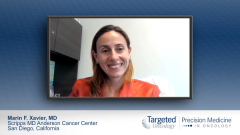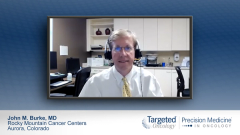
CD19-Targeted Therapy for DLBCL
The rationale for sequencing therapy with CD19-targeted agents when managing patients with various subtypes of diffuse large B-cell lymphoma.
Episodes in this series

Marin F. Xavier, MD: What are the greatest unmet needs for the available frontline options?
We have R-CHOP [rituximab, cyclophosphamide, hydroxydaunorubicin hydrochloride, vincristine, prednisone] plus drug X. As we said in the beginning, we’ve had a hard time establishing a practice change based on the many attempts. Who knows if the data for polatuzumab are going to change practice. So far, we have a pretty decent 1. R-CHOP [rituximab, cyclophosphamide, hydroxydaunorubicin hydrochloride, vincristine, prednisone] is less toxic than everything else in the chemotherapy land that they compared it with, even before the rituximab era.
Let’s move on to the meat of the discussion, which is CD19 as a target. This is a hot topic because while there was no drug approval, we had polatuzumab approved in the third-line setting with bendamustine and rituximab. For the longest time, the only other thing approved was CD19 CAR [chimeric antigen receptor] T-cell therapy a couple of years back. Now we have 2 other CD19-targeted therapies that are on the shelf for us to use. Tell me, Dr. Burke, what are the characteristics of a good therapeutic target in diffuse large B-cell lymphoma [DLBCL]? How does it function in healthy cells, and how does it differ from CD20?
John M. Burke, MD: For a targeted DLBCL, you want the target to be present on the cells. That’s 1 key feature. You don’t want a target that’s present or partially present. CD19 is a transmembrane protein that’s expressed on pretty much all B cells, perhaps more reliably than a CD20, which we’re all used to targeting in DLBCL and many other lymphomas. To my understanding, its function is to modulate B-cell receptor signaling, so that’s what it does in normal B cells. It’s been proven to be a really useful target in DLBCL and many other lymphomas with the advent of various types of drugs, from naked monoclonal antibodies in the form of tafasitamab, to antibody-drug conjugates with loncastuximab, to several CAR T-cell therapies. It’s very clear that CD19 is an excellent target in DLBCL.
Marin F. Xavier, MD: Yeah. My short answer would have been saying it’s just a pan–B-cell marker. I’m glad you tried to dig up some of that transmembrane B-cell–signaling science. For a clinician, we see it as a pan–B-cell marker. I agree that it’s more pervasive than CD20, especially in B-cell lymphomas.
One thing is that there could be different isotopes that some of these anti-CD19 therapies target. The CAR-T CD19 epitope may be different from the naked antibody and antibody-drug conjugate. We’re starting to see some data about it being effective to use another anti-CD19 as a bridge to CAR T, or that CAR-T failures still respond to CD19 therapy, non–CAR T after. We’re starting to get a little more data about that, mainly from tafasitamab. Because that was the first naked antibody available, we’re starting to have some real-world data emerge on that. Any thoughts about different targets for CD19? What do you know about using CD19 and then being able to do CD19 CAR T vs vice versa?
John M. Burke, MD: As you said, we’re starting to get some information on that, but we certainly don’t have the level of evidence that we’d love to have. There are some laboratory data from the Mayo Clinic suggesting that 1 does not necessarily lose sensitivity to CD19-targeting therapy between tafasitamab and CAR T-cell therapy. When tafasitamab was approved, I was hearing about a couple of case reports of patients getting 1 treatment after another and doing reasonably well. In the loncastuximab trial, they report patients—I forget exactly how many; I think it’s 9—who received loncastuximab and then went on to receive CAR T-cell therapy. They reported on the response rates in those patients, and it looked similar to the overall response rate of patients on the trial, something like in the 40s. So far there haven’t been a lot of clinical data suggesting that patients can’t respond to 1 treatment after the other. But there’s concern about that in the field.
Marin F. Xavier, MD: We haven’t been charged with talking about bispecifics, but that’s another exciting area that has CD20 and CD19. I’m looking forward to looking at that. Bispecifics work really well after CAR T failures in certain situations.
Transcript edited for clarity.







































